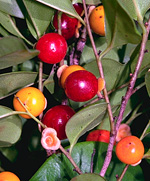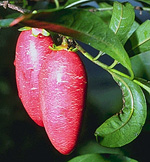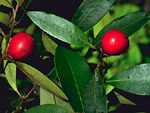 |
This is a small, pantropical family most diverse in Africa, with some species extending into temperate regions especially in East Asia. It is represented in Australia by the genus Diospyros only, comprising trees of rain forests, from the coastal subtropics of New South Wales around the north to the Kimberley region of Western Australia.
Characteristic features of the family Ebenaceae in Australia include: - small trees or shrubs with simple, alternate, entire leaves that may have translucent oil dots when young
- flowers unisexual and produced on separate plants, single or in small clusters in the leaf axils
- stamens with very short filaments, usually twice the number of the sepals and often inserted in pairs on the cup-shaped corolla, which is fused at the base only
- fruits are more or less succulent berries, usually partially enclosed by the enlarged fruiting calyx
Description
Evergreen or semi-deciduous trees or shrubs. Internal secretions not obvious. Plants glabrous or with simple, non-glandular, uniseriate hairs. Leaves alternate and spiral, or distichous, petiolate. Stipules and stipellae absent. Lamina simple, symmetric, lanceolate, ovate, elliptic, oblanceolate, obovate or oblong; base cuneate or attenuate; margins entire, ±flat, revolute or recurved; venation pinnate, with the midrib conspicuous, and the tertiary venation reticulate; surfaces not punctate; herbaceous or leathery. Male and female flowers occurring on the same plant or on separate plants, or with bisexual flowers and male and female flowers occurring on the same plant. Inflorescences axillary, consisting of glomerules, cymes or solitary flowers. Bracts present. Flowers sessile or stalked. Floral disc present or absent; nectaries ?absent. Perianth regular, of 2 dissimilar whorls. Calyx segments fused, with 3–6 lobes, valvate in bud; calyx cup-shaped; herbaceous or papery. Corolla segments fused, with 3–6 lobes, alternating with the calyx lobes, imbricate in bud; corolla wheel-shaped, cup-shaped or urn-shaped, white or cream, without contrasting markings, membranous or papery; claws absent; lobes ±entire. Fertile stamens 3–numerous, opposite to, or not clearly correlated with the calyx lobes, at least partly fused to the corolla, free of the ovary and style, distinct from each other, grouped or fused into bundles or fused by their filaments into an open or closed tube, all ±equal. Staminodes present. Anthers basifixed, not versatile, opening inwards by longitudinal slits, 2-celled. Ovary superior and sessile. Carpels 2–5, fused; ovary with 3–8 locules. Style terminal, single and branched above or from the base. Ovules 1 (–2) per locule, stalked; placentation apical or axile. Fruit a fleshy, indehiscent berry; the perianth on the maturing fruit deciduous, dry and persistent or growing larger. Disseminule micro-surface ±smooth, colliculate or alveolate, yellow, orange, red, brown, grey or black, glossy or dull. Seeds 1–10 per fruit. Aril absent. Cotyledons 2. Embryo straight or curved.
(Note: this description has been generated from the coded data compiled for the key. Any errors in the key data will be reflected in the descriptions.)
A treatment of the family Ebenaceae has not yet been published in the Flora of Australia. It will appear in Volume 10.
Australian genera of Ebenaceae (as recognised for the Flora of Australia)
Diospyros

|
  |

Diospyros cupulosa (fruits)
Photo: H.Nicholson © H. & N. Nicholson

Diospyros ferrea (flowers and fruit)
Photo: D.Jones © D.Jones

Diospyros mabacea (fruits)
Photo: H.Nicholson © H. & N. Nicholson

Diospyros pentamera (fruits)
Photo: G.Leiper © G.Leiper
|

| |